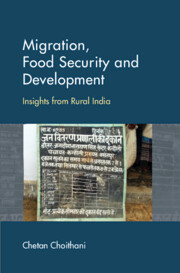Book contents
- Frontmatter
- Contents
- List of Figures, Tables and Boxes
- List of Photos
- Preface
- Acknowledgements
- List of Abbreviations
- 1 Introduction
- 2 Bridging the Disconnect between Migration and Food Security
- 3 Dynamics of Food Insecurity, Migration and Urbanisation in India
- 4 The Context of Migration
- 5 Connections between Food Safety Nets and Migration
- 6 Migration, Remittances, Land and Household Food Security
- 7 Opening the Household Box
- 8 Conclusion
- References
- Index
2 - Bridging the Disconnect between Migration and Food Security
Published online by Cambridge University Press: 22 February 2023
- Frontmatter
- Contents
- List of Figures, Tables and Boxes
- List of Photos
- Preface
- Acknowledgements
- List of Abbreviations
- 1 Introduction
- 2 Bridging the Disconnect between Migration and Food Security
- 3 Dynamics of Food Insecurity, Migration and Urbanisation in India
- 4 The Context of Migration
- 5 Connections between Food Safety Nets and Migration
- 6 Migration, Remittances, Land and Household Food Security
- 7 Opening the Household Box
- 8 Conclusion
- References
- Index
Summary
INTRODUCTION
Migration, both internal and international, has become a key component of the livelihood strategies of an increasing number of households in developing countries. The flow of migrants’ remittances has expanded significantly and is now a major contributor to the national income of several countries (World Bank, 2011a, 2019). This has promoted a spike in researchers’ and policymakers’ attention on the migration–development nexus. Importantly, unlike earlier periods when migration was often viewed as a problem with negative implications for development, there is now growing global consensus on its potential positive effects, including both financial as well as social benefits such as transfer of migrants’ skills and knowledge. Leading international organisations have therefore lent unequivocal institutional backing to encourage migration in the past few years (Department of International Development [DFID], 2007; UNDP, 2009; World Bank, 2009; International Organization for Migration [IOM], 2013, 2020). Consequently, after having been sidelined in the Millennium Development Goals (MDGs), its successor, the Sustainable Development Goals (SDGs), acknowledge the positive contributions migrants make in their source and destination communities, and migration and mobility have been included in 4 of the 17 SDGs (IOM, 2015).
Concurrently, the significance of food security for all as an important development objective has been growing, particularly since the 2007–08 global food crisis. The spikes in global food prices since 2006 stalled the global progress on hunger reduction, and in 2009, for the first time in human history, the number of undernourished people crossed a billion people (FAO, 2009). While hunger prevalence has fallen from its billion-plus peak, recent estimates suggest that even a decade later, in 2019, a staggering 690 million people remained chronically underfed. Moreover, hunger has been on the rise since 2014, even before the Covid-19 pandemic intensified global food insecurity, adding an estimated 83–132 million additional people to the ranks of the undernourished. Additionally, nearly two billion people in the world experience moderate to severe food insecurity. A large majority of the world's hungry and food-insecure populations reside in the rural areas of the developing world (FAO et al., 2020). The sheer magnitude of hunger has warranted calls for effective action on hunger reduction. At the United Nations Conference on Sustainable Development in Rio de Janeiro in 2012, the then UN Secretary General, Ban Ki-moon, launched the ‘Zero Hunger Challenge’, calling the member countries to work for a future where no one in the world goes to bed hungry.
- Type
- Chapter
- Information
- Migration, Food Security and DevelopmentInsights from Rural India, pp. 27 - 62Publisher: Cambridge University PressPrint publication year: 2023



